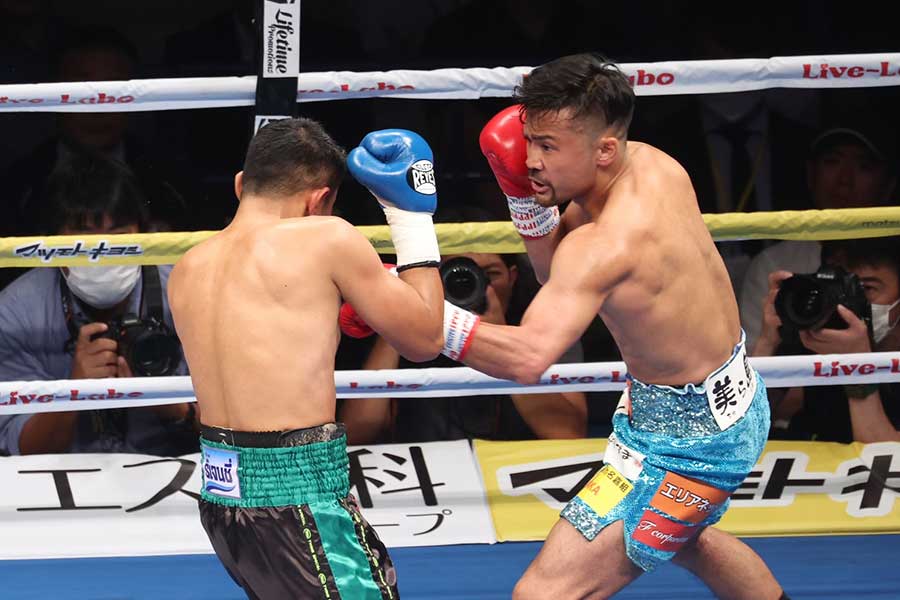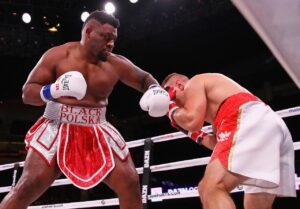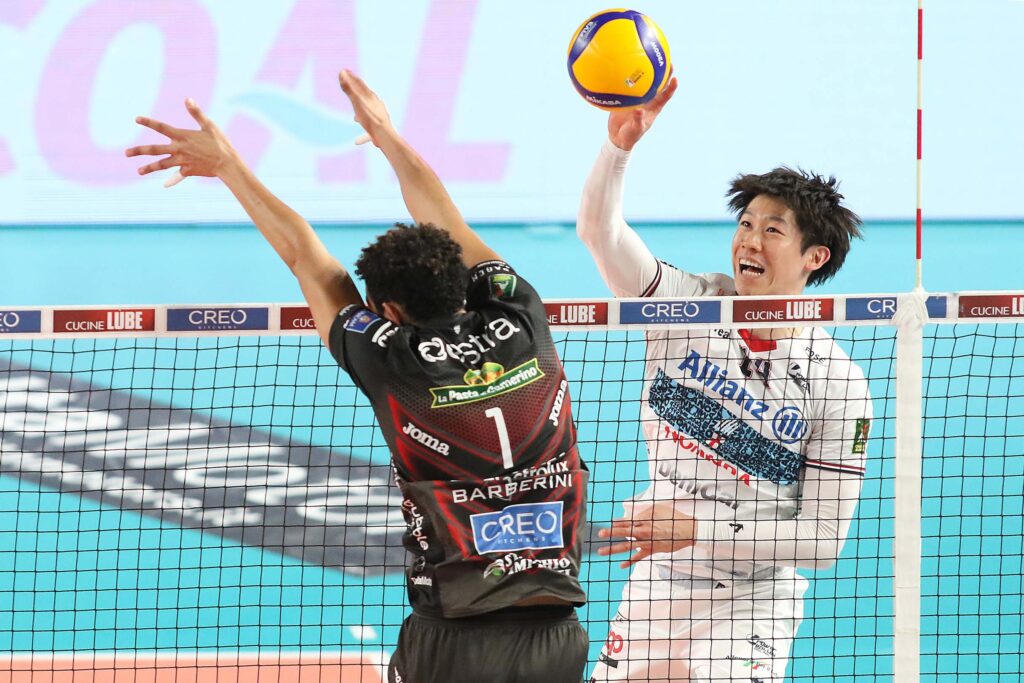
Proper form and technique maximize power and efficiency in boxing punches.
The basic types of punches include jabs, straights (straight right), hooks, and uppercuts, each of which has a different purpose and effect.
Here, we will explain in detail how to throw these punches, and then explain how to strengthen the punching power, how to put your weight on it, how to combine it with defensive techniques, and advice for people who can’t hit uppercuts well.
目次
How to throw a punch in boxing
jab
The jab is one of the basics of boxing and is the most commonly used punch. It is used to measure reach and break down the opponent’s guard.
- Basic position: Feet slightly wider than shoulder width, front foot in front, back foot at a 45 degree angle.
- Execution: Quickly extend your front hand forward in a straight line while rotating your forearm. At the moment of punching, the fist should be horizontal.
- Return motion: Immediately return your hands to the guard position.
Straight (right straight)
A straight is a power punch, especially with the back hand (for many boxers, the right hand).
- Basic stance: Same as jab, but this punch is thrown from the back hand.
- Execution: Extend your back hand forward in a straight line while rotating your shoulders and hips. This movement begins with the toes of your back foot, transmitting power through your hips, shoulders, and into your fists.
- Return motion: Immediately return your hands to the guard position after throwing a punch.
hook
The hook is aimed at the opponent’s sides, especially the jaw and side of the head.
- Basic position: Start in the same way as a jab or straight.
- Execution: Slightly bend your knees and swing your bent arm from your side toward your opponent by rotating your hips and shoulders. The striking surface should be such that your forearm is vertical.
- Return action: Immediately return to a defensive position after releasing the hook.
uppercut
An uppercut is a punch aimed at the chin from under the opponent’s guard.
- Basic position: Start from the same starting position as the other punches.
- Execution: Bend your knees slightly, lower your hips on the side of your hitting hand, and swing your arms upward in a semicircular motion. When punching, keep your fist vertical.
- Return motion: Immediately return your hand to guard position after punching.
These punches are the basic attacks in boxing, and each is most effective in different situations.
Proper form, speed, power, and the ability to combine them make an effective boxer. Please stick to the basics and practice repeatedly.

How to do boxing combinations
Combinations in boxing are techniques in which multiple punches are thrown in succession in order to damage an opponent or break down his defense.
Hitting combinations effectively focuses on timing, speed, force distribution, and unpredictability.
Here we will introduce basic combinations for beginners and points to keep in mind when performing them.
basic combination
-
Jab – Cross (1-2)
- Jab : Punch forward with your forearm horizontal while pivoting on your front foot. It is used to break down the opponent’s defense and measure distance.
- Cross : After a jab, a powerful straight punch with the opposite hand. Cross is performed by shifting the weight from the front foot to the back foot and using the rotation of the hips.
-
Jab – Cross – Hook
- Hook : After a cross, bend your arm and hit your opponent from the side to the face or body. It uses hip rotation and leg movement to generate power.
-
jab – uppercut
- Uppercut : When the opponent has lowered their guard, strike from below to above, aiming at the chin or body. Uppercuts are effective punches, especially in close quarters combat.
Key points on how to hit combinations
- Rhythm and Speed : In combinations, change the rhythm between punches to throw off your opponent’s timing. He creates an unpredictable rhythm, such as a quick jab followed by a momentary pause before a cross.
- Body rotation and center of gravity shift : Body rotation and center of gravity shift are important in order to deliver a powerful punch. Especially in crosses and hooks, use your hip rotation effectively.
- Maintaining your guard : It is also important to maintain your guard when hitting combinations to reduce the risk of being hit. After you throw one punch, protect your face with your other hand.
- Footwork : Combinations on the move are more unpredictable for your opponent. You can continue punching as you step forward, step back, and move sideways.
Combinations need to be practiced repeatedly and ingrained in your body in order to be able to use them effectively in actual combat.
Build speed, accuracy, and power through a variety of training methods, including shadow boxing, punching bags, and mitt hitting.

How to increase punching power
To improve your punching power in boxing, you need to learn technique, improve your physical strength, and understand strategy.
Below, we will introduce practice methods and training points to improve your punching power in boxing.
1. Learn and practice basic techniques
- Punch with correct form : The basis of punching power is correct form. Master the correct way to throw each punch, including jabs, straights, hooks, and uppercuts.
- Shadow Boxing : Shadow box in front of a mirror to check your form accuracy and fluidity.
2. Strength training
- Core Training : Most of your punching power comes from your hips and torso. Strengthen your core with exercises like planks, crunches, and Russian twists.
- Arm and Shoulder Workouts : Improve arm and shoulder strength with push-ups, dumbbell curls, shoulder presses, and more.
- Leg strength training : Strengthen your lower body with exercises like squats and lunges so you can effectively transfer force from the ground when punching.
3. Improve punch speed and power
- Heavy bag training : Increase the power and durability of your punches by training with a heavy bag. Let’s repeatedly punch the bag with full power to teach our body how to punch powerfully.
- Speed Bag Training : Use a speed bag to improve your sense of rhythm and punch speed. You can train speed and accuracy at the same time.
4. Improving punching techniques
- Practice Combinations : To land effective punches in real combat, it is important to attack with combinations rather than single punches. Practice combining different punches.
- Counter Punching : Practicing counter punching, where you dodge your opponent’s attacks and then counterattack, will also help improve your punching power.
5. Points other than exercise
- Proper nutrition and rest : A balanced diet and adequate rest are essential for muscle growth and recovery.
- Regular rest : Overtraining can be counterproductive. Maximize the effects of your training by giving your body proper rest.
Improving your punching power in boxing is not something that can be achieved in a day or two.
Gradually improve your punching power by making steady efforts and using the correct training method.

How to put weight on a punch
How you put your weight on your punch is important to create a more powerful blow.
Here are some steps about the technology
-
Basic stance : First, take a proper stance. Stand with your feet slightly wider than shoulder-width apart and place one foot slightly in front of you. The foot that comes forward should correspond to your dominant hand (for example, if you are right-handed, put your left foot in front). Keep your body relaxed and your knees slightly bent.
-
Rotation of the hips : The power of a punch is generated not only from the arms, but also from the rotation of the hips. When throwing a punch, actively rotate your hips and synchronize that movement with the punch. This allows you to put your whole body’s power into the punch.
-
How to use your feet : When throwing a punch, lift the heel of your back foot slightly off the floor and use that foot to kick the ground, transmitting the force forward. This movement provides additional power to the punch and helps you put your weight on it.
-
Shifting your center of gravity : When punching, shift your weight from your front foot to your back foot and back to your front foot. This shift in the center of gravity is the key to effectively putting your weight on the punch. When you throw a punch, be sure to place your center of gravity on your front foot.
-
Practice and Repetition : Practice and repetition are essential to mastering the weighted punch. Practice these movements through shadow boxing, punching bags, hitting mitts, etc. to make them come naturally.
Simply creating a state in which your body moves slightly forward at the moment the punch hits your opponent will increase the power of your straight or hook.
Also, simply shaking your head in time with the punch will add weight to the punch.
With proper technique and practice, you will be able to effectively place your weight on the punch.
Let’s aim to improve one step at a time while being careful about safety.

Combination with defense technology
In boxing, the combination of punches and defensive techniques is an essential element to success in a match.
Below are some basic punch and defensive technique combinations. These are used to effectively counterattack while responding to the opponent’s attacks.
1. Jab and slip
- Jab : Used to take advantage of your reach and suppress your opponent.
- Slip : Avoid your opponent’s punch by moving your head to the side. After hitting a jab, you can immediately slip to avoid your opponent’s counter.
2. Straight (cross) and weave
- Straight (cross) : A powerful punch, delivered in a straight line aiming at the opening created by the jab.
- Weave : Lower your upper body and move from side to side to avoid your opponent’s punches. After a straight, use a weave to avoid your opponent’s counterattack and wait for a counter opportunity.
3. Hooks and covers
- Hook : A punch thrown into the opponent from the side with a bent arm. Effective at close range.
- Cover : Protect your face and body with your arms and look for an opportunity to counterattack. After the hook, maintain a high guard in case your opponent counterattacks.
4. Uppercut and clinch
- Uppercut : A powerful punch from the bottom upwards. Aim under your opponent’s guard.
- Clinch : Hold your opponent and temporarily interrupt the fight. After an uppercut, use the clinch to prevent your opponent from counterattacking and give yourself time to reset.
5. Combinations and footwork
- Combination : Land multiple punches in quick succession. For example, the basic combination is jab → straight → hook.
- Footwork : Positioning and movement around the ring. After the combination, use quick footwork to distance yourself and protect yourself from your opponent’s counterattack.
Although these techniques are basic, endless variations can be created by combining them.
With practice, you will be able to use these movements naturally and depending on the situation.
Being able to keep pressure on your opponent while maintaining a good balance between defense and attack will greatly improve your boxing skills.

How to punch in specific situations (after a clinch, against a tall opponent, etc.)
In boxing, it is important to use specific strategies and techniques when your opponent is taller or has a longer reach than you.
Also, it will be advantageous to know how to throw effective punches when escaping from the clinch as part of your strategy.
Below, we will introduce how to play in these situations.
Measures against tall opponents or opponents with long reach
-
Body Shots : Against taller opponents, approach the lower body and use more body strikes to compensate for the reach difference. Punches to the body have the effect of reducing the opponent’s stamina and lowering their defense.
-
Use of infighting : Get inside the opponent’s reach and actively engage in “infighting” to fight at close range. In an infight, uppercuts and short hooks are effective.
-
Changing footwork and angles : Use quick footwork to avoid your opponent’s attacks while changing the angle of your attack. This allows you to offset your opponent’s reach length advantage.
How to throw punches when coming out of the clinch
-
Short punches when breaking out of a clinch : Short punches are effective when breaking out of a clinch, as you are very close to your opponent. At the moment you release the clinch, take advantage of your opponent’s lowered guard and aim for an uppercut or short hook.
-
Quick jab after breaking out of the clinch : Immediately after breaking out of the clinch, use a quick jab to regain distance. This will keep your opponent in check while preparing them for the next attack.
-
Counter punches to the body : When you break out of the clinch, you can expect your opponent to attack you, so it is also effective to take advantage of that moment and aim for a counter punch to the body.
Implementing these tactics requires footwork, timing, and the ability to anticipate your opponent’s movements.
Acquiring these techniques through practice and being able to respond flexibly to various situations is the key to success in boxing.

Advice for those who can’t hit the uppercut well
If you’re having trouble hitting a good uppercut, the following advice may help.
By practicing these points, you can improve your uppercut technique
-
Check your basic stance : Start with the correct stance. Stand with your feet slightly wider than shoulder-width apart and your knees slightly bent to keep yourself relaxed. Starting your punch from this position increases your stability and allows you to transfer your power more effectively.
-
Use of the hips : Uppercuts generate a lot of force through the movement of the hips, not just the arms. When throwing a punch, try to add force by slightly rotating your hips. This rotation of the hips is the key to creating a powerful uppercut.
-
Elbow position : Keep your elbows close to your body when performing an uppercut. This allows you to transfer power more efficiently and punch with more control. Be careful not to open your elbows outward.
-
How to bend your knees : When throwing an uppercut, bend your knees slightly before launching the punch. This action harnesses the force from the ground to provide acceleration to the punch, helping to create a more powerful blow.
-
Be aware of your goals : It’s also important to have a clear goal for your punch. The uppercut concentrates the force upward, so aim for the opponent’s jaw or the center of the body. Keep this goal in mind during practice and try to hit accurately.
-
Stay Balanced : To land a powerful uppercut, you need a balanced posture. When throwing a punch, distribute your weight evenly between your front and back legs and maintain a stable stance.
-
Repetitive practice : Practice is essential for any skill. Use shadow boxing, heavy bag, and mitt training to practice uppercut repetitions and improve both form and power.
The uppercut is a complex technique, but with proper practice and practice, it can be effectively mastered.
It’s helpful to practice patiently and sometimes seek feedback from a trainer or an experienced boxer.
If you remember that the uppercut is not a punch that emphasizes destructive power (it shakes the head vertically, so even if the destructive power is less than a straight punch, it will still do a lot of damage to the opponent), you can use the uppercut more effectively. You might be able to roll it out.





